|
项目 |
内容 |
|
这个作业属于哪个课程 |
https://www.cnblogs.com/nwnu-daizh/ |
|
这个作业的要求在哪里 |
https://www.cnblogs.com/nwnu-daizh/p/11435127.html |
|
作业学习目标 |
|
实验内容和步骤
实验1:在“System.out.println(...);”语句处按注释要求设计代码替换...,观察代码录入中IDE提示,以验证四种权限修饰符的用法。(20分)
代码如下:
子类代码:
package zhuwenben;
public class Parent {
private String p1 = "这是Parent的私有属性";
public String p2 = "这是Parent的公有属性";
protected String p3 = "这是Parent受保护的属性";
String p4 = "这是Parent的默认属性";
private void pMethod1() {
System.out.println("我是Parent用private修饰符修饰的方法");
}
public void pMethod2() {
System.out.println("我是Parent用public修饰符修饰的方法");
}
protected void pMethod3() {
System.out.println("我是Parent用protected修饰符修饰的方法");
}
void pMethod4() {
System.out.println("我是Parent无修饰符修饰的方法");
}
}
parent代码:
package zhuwenben;
public class Demo {
public static void main(String[] args) {
Parent parent=new Parent();
Son son=new Son();
son.pMethod3();//分别尝试用parent调用Paren类的方法、用son调用Son类的方法
}
}
class Son extends Parent{
private String s1 = "这是Son的私有属性";
public String s2 = "这是Son的公有属性";
protected String s3 = "这是Son受保护的属性";
String s4 = "这是Son的默认属性";
public void sMethod1() {
System.out.println(p2);//分别尝试显示Parent类的p1、p2、p3、p4值
System.out.println("我是Son用public修饰符修饰的方法");
}
private void sMethod2() {
System.out.println("我是Son用private修饰符修饰的方法");
}
protected void sMethod() {
System.out.println("我是Son用protected修饰符修饰的方法");
}
void sMethod4() {
System.out.println("我是Son无修饰符修饰的方法");
}
}
运行结果如下:
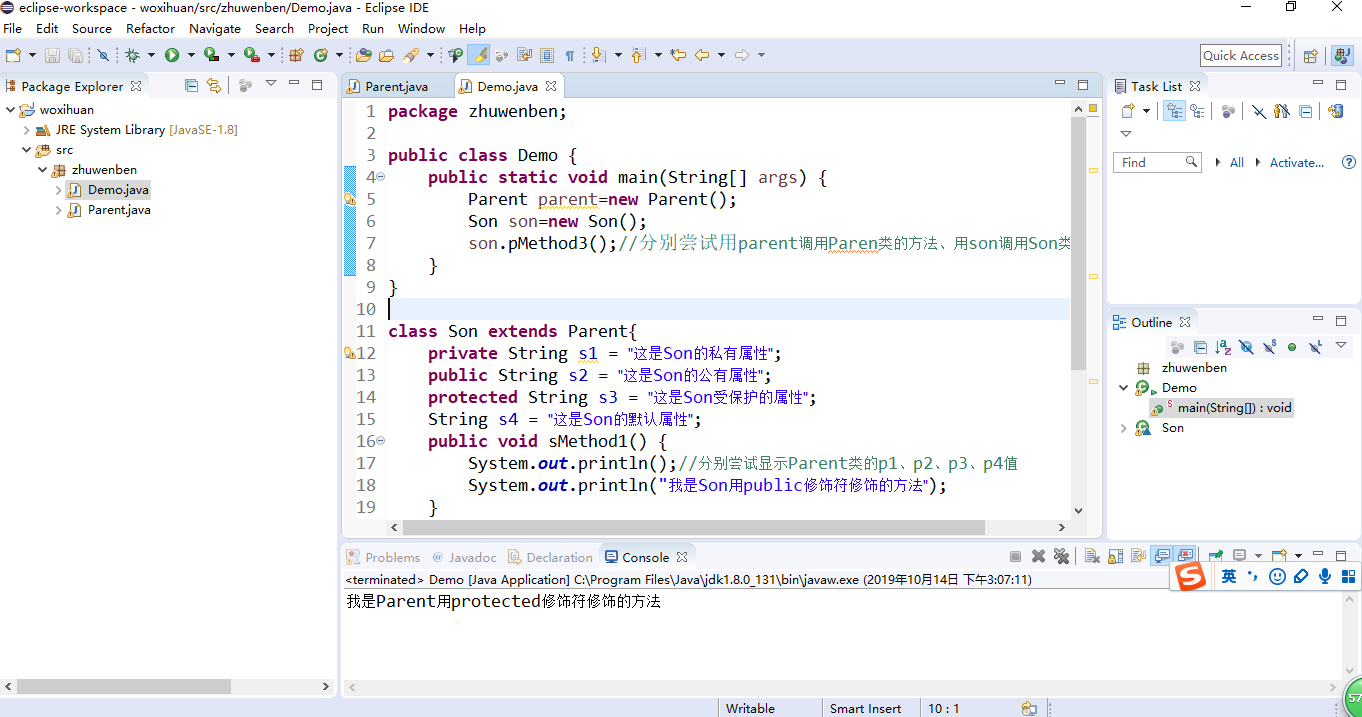
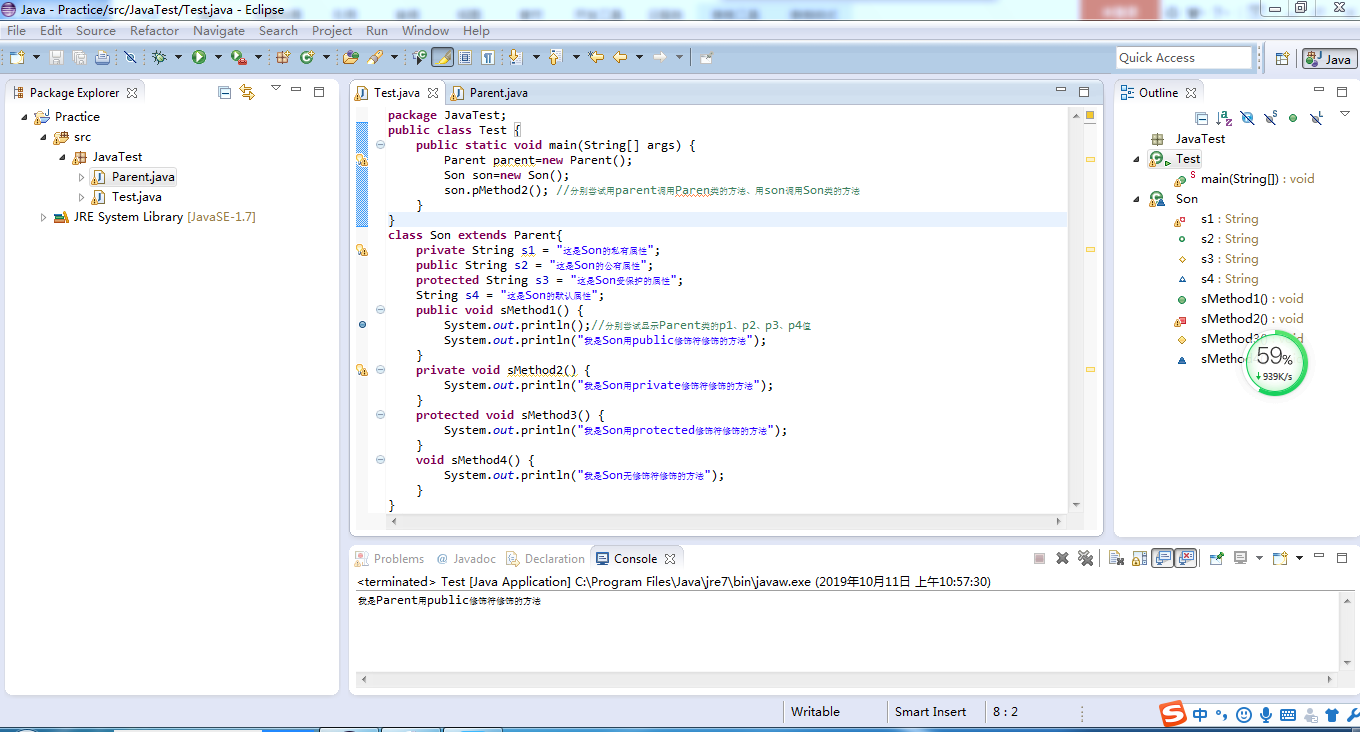
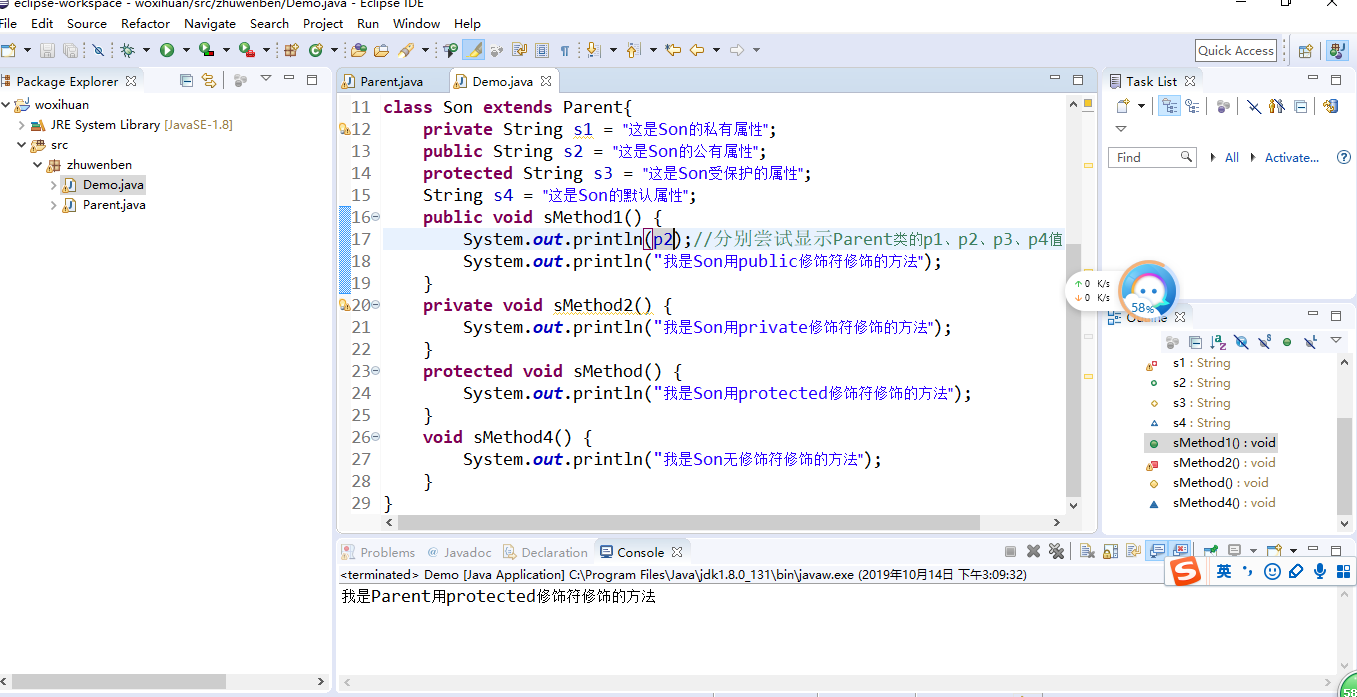

结论:
权限控制表
修饰词 本类 同一个包的类 继承类 其他类
private √ × × ×
无(默认) √ √ × ×
protected √ √ √ ×
public √ √ √ √
实验2:测试程序1
l 运行教材程序5-8、5-9、5-10,结合程序运行结果理解程序(教材174页-177页);
实验代码如下:
package equals;
import java.time.*;import java.util.Objects;public class Employee{ private String name; private double salary; private LocalDate hireDay; public Employee(String name, double salary, int year, int month, int day) { this.name = name; this.salary = salary; hireDay = LocalDate.of(year, month, day); } public String getName() { return name; } public double getSalary() { return salary; } public LocalDate getHireDay() { return hireDay; } public void raiseSalary(double byPercent) { double raise = salary * byPercent / 100; salary += raise; } public boolean equals(Object otherObject) { // a quick test to see if the objects are identical if (this == otherObject) return true; //检查这些值是否相等 // must return false if the explicit parameter is null if (otherObject == null) return false; //如果显示参数为空,则返回false // if the classes don't match, they can't be equal if (getClass() != otherObject.getClass()) return false; //如果类不相等,则它们不匹配 // now we know otherObject is a non-null Employee Employee other = (Employee) otherObject; //otherObject 是一个非空雇员对象 // test whether the fields have identical values return Objects.equals(name, other.name) && salary == other.salary && Objects.equals(hireDay, other.hireDay); //检测它们是否具有相同的值 } public int hashCode() { return Objects.hash(name, salary, hireDay); } public String toString() { return getClass().getName() + "[name=" + name + ",salary=" + salary + ",hireDay=" + hireDay + "]"; }}(2)
package equals;
public class Manager extends Employee //子类Manager类继承父类Employee类{ private double bonus; public Manager(String name, double salary, int year, int month, int day) //Manager构造器 { super(name, salary, year, month, day); bonus = 0; } public double getSalary() // { double baseSalary = super.getSalary(); return baseSalary + bonus; } public void setBonus(double bonus) { this.bonus = bonus; } public boolean equals(Object otherObject) { if (!super.equals(otherObject)) return false; //检查是否属于同一个类 Manager other = (Manager) otherObject; // super.equals checked that this and other belong to the same class return bonus == other.bonus; } public int hashCode() { return java.util.Objects.hash(super.hashCode(), bonus); } public String toString() { return super.toString() + "[bonus=" + bonus + "]"; }}(3)
package equals;
/** * This program demonstrates the equals method. * @version 1.12 2012-01-26 * @author Cay Horstmann */public class EqualsTest{ public static void main(String[] args) { Employee alice1 = new Employee("Alice Adams", 75000, 1987, 12, 15); Employee alice2 = alice1; Employee alice3 = new Employee("Alice Adams", 75000, 1987, 12, 15); Employee bob = new Employee("Bob Brandson", 50000, 1989, 10, 1); System.out.println("alice1 == alice2: " + (alice1 == alice2)); System.out.println("alice1 == alice3: " + (alice1 == alice3)); System.out.println("alice1.equals(alice3): " + alice1.equals(alice3)); System.out.println("alice1.equals(bob): " + alice1.equals(bob)); System.out.println("bob.toString(): " + bob); Manager carl = new Manager("Carl Cracker", 80000, 1987, 12, 15); Manager boss = new Manager("Carl Cracker", 80000, 1987, 12, 15); boss.setBonus(5000); System.out.println("boss.toString(): " + boss); System.out.println("carl.equals(boss): " + carl.equals(boss)); System.out.println("alice1.hashCode(): " + alice1.hashCode()); System.out.println("alice3.hashCode(): " + alice3.hashCode()); System.out.println("bob.hashCode(): " + bob.hashCode()); System.out.println("carl.hashCode(): " + carl.hashCode()); }}运行结果如下:

l 删除程序中Employee类、Manager类中的equals()、hasCode()、toString()方法,背录删除方法,在代码录入中理解类中重写Object父类方法的技术要点。(15分)
Employee类重写后代码如下:
package equals;
import java.time.*;
import java.util.Objects;
public class Employee
{
private String name; //实例域定义
private double salary;
private LocalDate hireDay;
public Employee(String name, double salary, int year, int month, int day)//构造器定义
{
this.name = name;
this.salary = salary;
hireDay = LocalDate.of(year, month, day);
}
public String getName() {
return name;
}
public double getSalary() {
return salary;
}
public LocalDate getHireDay() {
return hireDay;
}
public void raiseSalary(double byPercent)
{
double raise=salary*byPercent/100;
salary+=raise;
}
@Override
public boolean equals(Object otherObject) {
// TODO Auto-generated method stub
if(this==otherObject) return true;
if(this==null) return false;
if(getClass() != otherObject.getClass()) return false;
Employee other=(Employee)otherObject;
return Objects.equals(name,other.name)&&salary == other.salary&&Objects.equals(hireDay,other.hireDay);
}
@Override
public int hashCode() {
// TODO Auto-generated method stub
return Objects.hash(name,salary,hireDay);
}
@Override
public String toString() {
// TODO Auto-generated method stub
return getClass().getName()+"[name="+name+",salary="+salary+",hireday="+hireDay+"]";
}
}
Manager类重写之后代码如下:
package equals;
/**
* This program demonstrates the equals method.
* @version 1.12 2012-01-26
* @author Cay Horstmann
*/
public class EqualsTest
{
public static void main(String[] args)
{
Employee alice1 = new Employee("Alice Adams", 75000, 1987, 12, 15);
Employee alice2 = alice1;
Employee alice3 = new Employee("Alice Adams", 75000, 1987, 12, 15);
Employee bob = new Employee("Bob Brandson", 50000, 1989, 10, 1);
System.out.println("alice1 == alice2: " + (alice1 == alice2));
System.out.println("alice1 == alice3: " + (alice1 == alice3));
System.out.println("alice1.equals(alice3): " + alice1.equals(alice3));
System.out.println("alice1.equals(bob): " + alice1.equals(bob));
System.out.println("bob.toString(): " + bob);
Manager carl = new Manager("Carl Cracker", 80000, 1987, 12, 15);
Manager boss = new Manager("Carl Cracker", 80000, 1987, 12, 15);
boss.setBonus(5000);
System.out.println("boss.toString(): " + boss);
System.out.println("carl.equals(boss): " + carl.equals(boss));
System.out.println("alice1.hashCode(): " + alice1.hashCode());
System.out.println("alice3.hashCode(): " + alice3.hashCode());
System.out.println("bob.hashCode(): " + bob.hashCode());
System.out.println("carl.hashCode(): " + carl.hashCode());
}
}
(3)EmployeeTest类代码如下:
package equals;
public class Manager extends Employee
{
private double bonus;
public Manager(String name, double salary, int year, int month, int day) {
super(name, salary, year, month, day);
// TODO Auto-generated constructor stub
bonus = 0;
}
public void setBonus(double bonus) {
this.bonus = bonus;
}
@Override
public double getSalary() {
// TODO Auto-generated method stub
double baseSalary= super.getSalary();
return baseSalary+bonus;
}
@Override
public boolean equals(Object otherObject) {
// TODO Auto-generated method stub
if(!super.equals(otherObject)) return false;
Manager other=(Manager)otherObject;
return bonus==other.bonus;
}
@Override
public int hashCode() {
// TODO Auto-generated method stub
return super.hashCode()+17*new Double(bonus).hashCode();
}
@Override
public String toString() {
// TODO Auto-generated method stub
return super.toString()+"[bonus="+bonus+"]";
}
}
运行结果如下:

实验2:测试程序2
l 在elipse IDE中调试运行程序5-11(教材182页),结合程序运行结果理解程序;
l 掌握ArrayList类的定义及用法;
l 在程序中相关代码处添加新知识的注释;
实验代码如下:
package arrayList;
import java.util.*;
/**
* This program demonstrates the ArrayList class.
* @version 1.11 2012-01-26
* @author Cay Horstmann
*/
public class ArrayListTest
{
public static void main(String[] args)
{
// fill the staff array list with three Employee objects
ArrayList<Employee> staff = new ArrayList<Employee>();
staff.add(new Employee("Carl Cracker", 75000, 1987, 12, 15));
staff.add(new Employee("Harry Hacker", 50000, 1989, 10, 1));
staff.add(new Employee("Tony Tester", 40000, 1990, 3, 15));
// raise everyone's salary by 5%
for (Employee e : staff)
e.raiseSalary(5);
// print out information about all Employee objects
for (Employee e : staff)
System.out.println("name=" + e.getName() + ",salary=" + e.getSalary() + ",hireDay="
+ e.getHireDay());
}
}
(2)
package arrayList;
import java.time.*;
public class Employee
{
private String name;
private double salary;
private LocalDate hireDay;
public Employee(String name, double salary, int year, int month, int day)
{
this.name = name;
this.salary = salary;
hireDay = LocalDate.of(year, month, day);
}
public String getName()
{
return name;
}
public double getSalary()
{
return salary;
}
public LocalDate getHireDay()
{
return hireDay;
}
public void raiseSalary(double byPercent)
{
double raise = salary * byPercent / 100;
salary += raise;
}
}
运行结果如下:

实验2:测试程序3
l 编辑、编译、调试运行程序5-12(教材189页),结合运行结果理解程序;
l 掌握枚举类的定义及用法;
l 在程序中相关代码处添加新知识的注释;
实验代码如下:
package enums;
import java.util.*;
/**
* This program demonstrates enumerated types.
* @version 1.0 2004-05-24
* @author Cay Horstmann
*/
public class EnumTest
{
public static void main(String[] args)
{
Scanner in = new Scanner(System.in);
System.out.print("Enter a size: (SMALL, MEDIUM, LARGE, EXTRA_LARGE) ");
String input = in.next().toUpperCase();
Size size = Enum.valueOf(Size.class, input);
System.out.println("size=" + size);
System.out.println("abbreviation=" + size.getAbbreviation());
if (size == Size.EXTRA_LARGE)
System.out.println("Good job--you paid attention to the _.");
}
}
enum Size
{
SMALL("S"), MEDIUM("M"), LARGE("L"), EXTRA_LARGE("XL");
private Size(String abbreviation) { this.abbreviation = abbreviation; }
public String getAbbreviation() { return abbreviation; }
private String abbreviation;
}
运行结果如下:
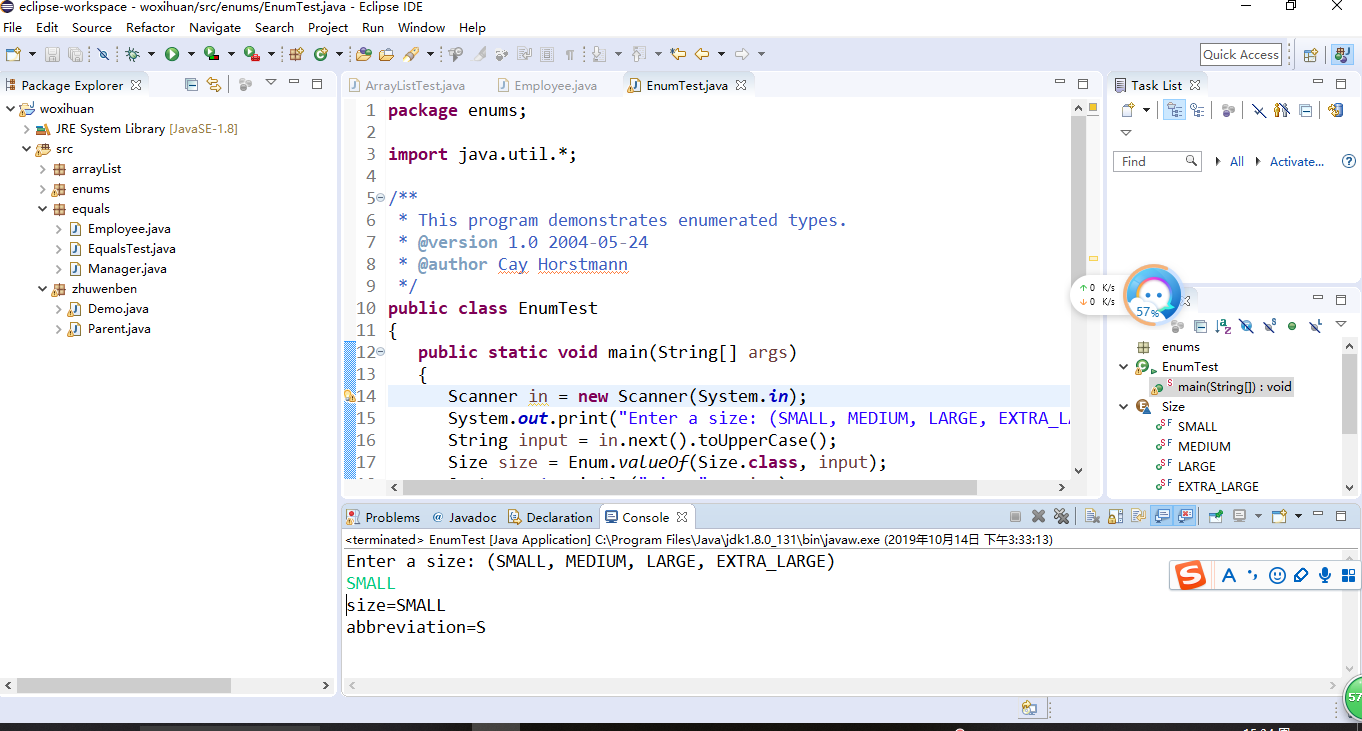
测试程序4:录入以下代码,结合程序运行结果了解方法的可变参数用法
public class TestVarArgus {
public static void dealArray(int... intArray){
for (int i : intArray)
System.out.print(i +" ");
System.out.println();
}
public static void main(String args[]){
dealArray();
dealArray(1);
dealArray(1, 2, 3);
}
}
运行结果如下:
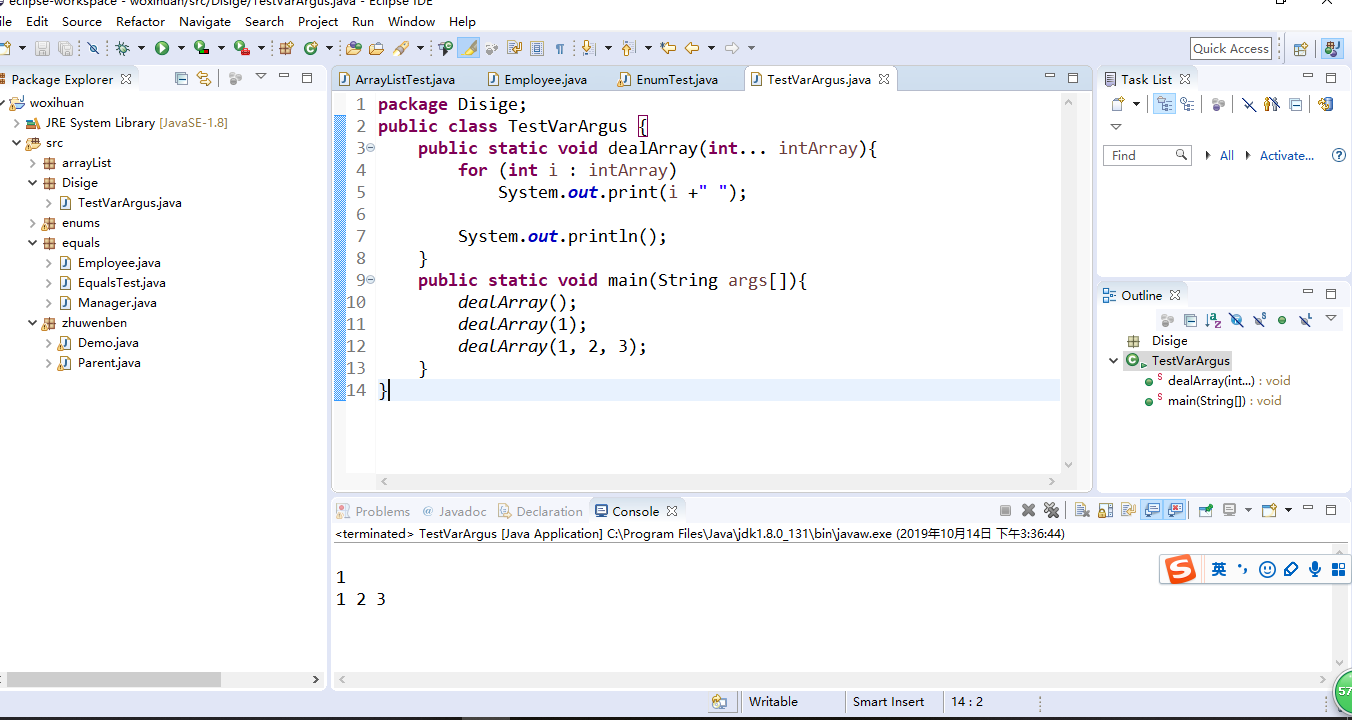
定义为字符串类型实验代码如下:
package Disige;
public class TestVarArgus {
public static void dealArray(String...StringArray){
for (String i : StringArray)
System.out.print(i +" ");
System.out.println();
}
public static void main(String args[]){
dealArray("my name is zxx");
dealArray("I come from China");
dealArray"I love China");
}
}
运行结果如下:
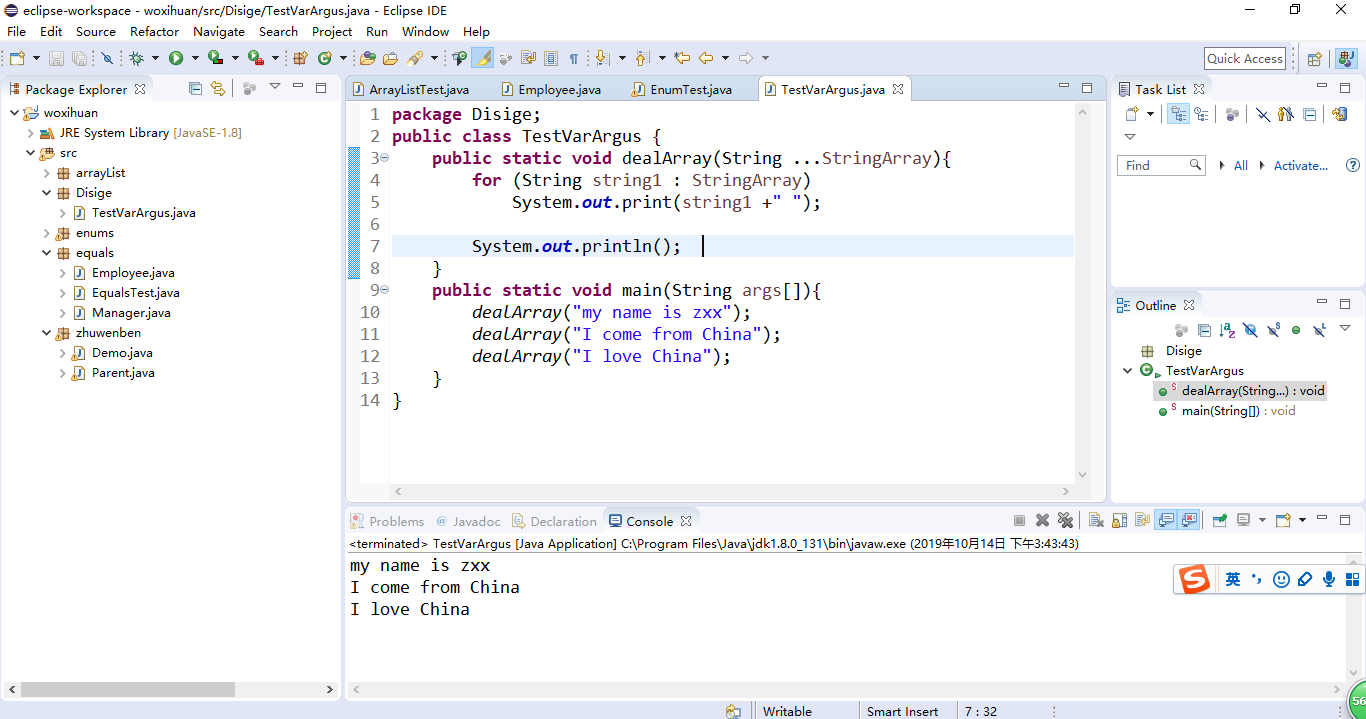
(3)整形:
package Disige;
public class TestVarArgus {
public static void dealArray(int...intArray){
for (int i : intArray)
System.out.print(i +" ");
System.out.println();
}
public static void main(String args[]){
dealArray(2);
dealArray(2,8);
dealArray(2,8,2,8);
}
}
运行结果如下:

实验3:编程练习 参照输出样例补全程序,使程序输出结果与输出样例一致。( 10分)
实验代码如下:
public class Demo {
public static void main(String[] args) {
Son son = new Son();
son.method();
}
}
class Parent {
Parent() {
System.out.println("Parent's Constructor without parameter");
}
Parent(boolean b) {
System.out.println("Parent's Constructor with a boolean parameter");
}
public void method() {
System.out.println("Parent's method()");
}
}
class Son extends Parent {
//补全本类定义
Son(){
super(false);
System.out.println("Son's Constructor without parameter");
}
public void method() {
System.out.println("Son's method()");
super.method();
}
}
运行结果如下:
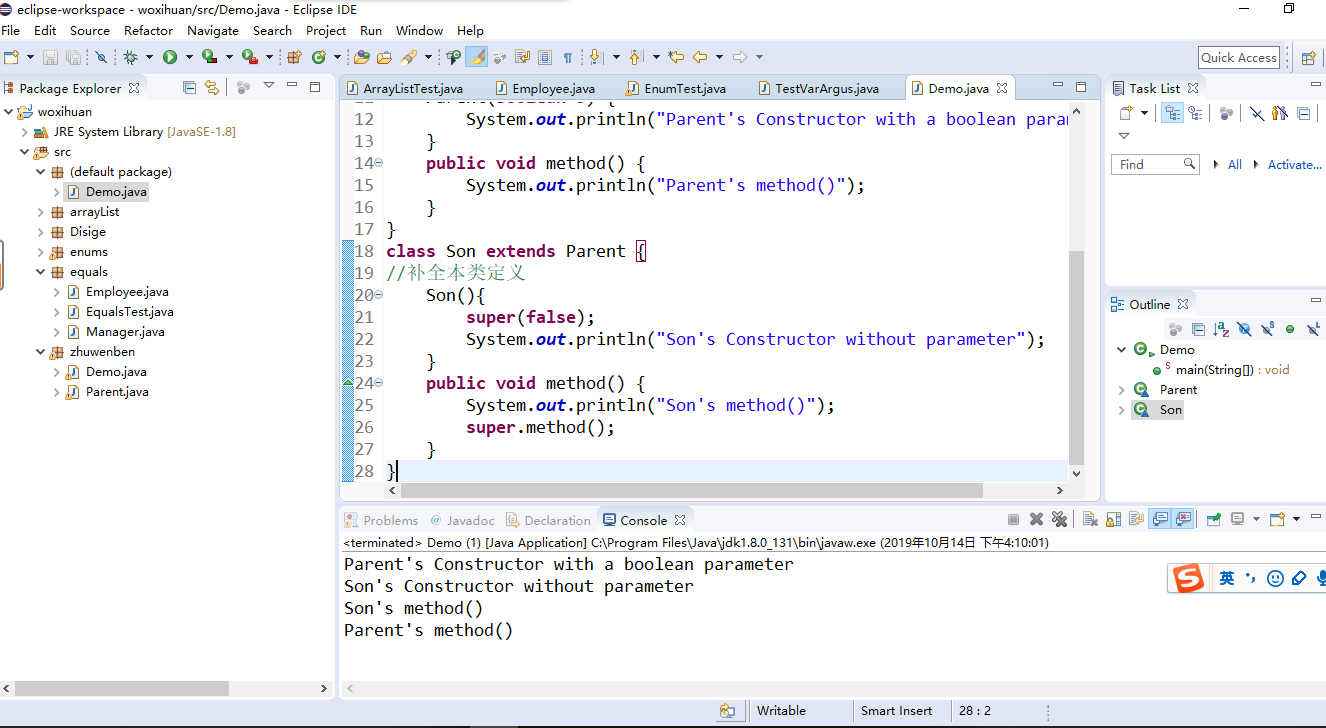
第三部分:实验总结
在老师上课梳理脉络的前提下,我通过这周的自主学习,掌握了关于继承的相关知识和实验技能。这周的时间很充足,所以在这个假期我很好的将以前所学知识和第五、六周所学结合起来,融会贯通。一步一步完成了学习任务。实验并没有太大的的问题,但是在完成老师布置的自主实验时,因为知识掌握能力的不足,写程序的时候思维逻辑并不是很清晰,所以程序代码可能有点凌乱,不过还是完成了题目要求的内容。通过这一个多月Java的学习,自己对程序语言又有了更深的理解,每次试验后,自己的反思和老师的点评,还有学长和同窗的指教都给了我很大的提升。而且通过老师的这种学习模式更好的培养了我们最欠缺的自主学习能力。很大程度上提升了我们的可塑性和可持续发展性。